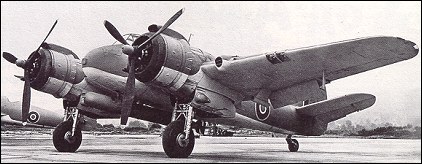The Internet Museum of World War II Aviation | home
Great Britain | Blackburn Roc | Firebrand | Defiant | Beaufighter | Mosquito | Fairey Firefly | Fairey Fulmar | Gladiator | Gloster Meteor | Hawker Hurricane | Hawker Tempest | Hawker Typhoon | Spitfire
Beaufighter
The Bristol Beaufighter was one of many British twin engined fighters to be highly successful. It evolved from the bomber Bristol Blenheim, and thus development was rather short. Months before the Second World War even began, in June of 1939, the prototype Beaufighter was flown before officials of the RAF and 300 of the machines were ordered. Basically, the purpose of the Beaufighter was to be very heavily armed, fast, and able to take many hits, including losing an engine to enemy fire, and continue flying. As you can tell from the photograph, the Beaufighter was big and very tough, and armed to the tooth. The early Beaufighters carried four 20-mm cannon in the lower nose, six .303-calibre machine guns in the wings, and four more .303-calibre machine guns beside the nose section forward firing. Also, there were a few models with eight .303-calibre guns in the wings instead of six. With all the guns blazing, over 17 pounds of explosive and lead was being thrown from this fighter every second.
The fighter was capable of carrying all this armament and still retain its maneuverability and control. Although it might not be a match for a single engine high performance fighter, it could destroy everything else that flew. It also made a superb night fighter, being fitted almost instantly with the 1.5 meter A.I. Mk IV radar installation. They began operating as night fighters during the Battle of Britain, and there scored its first kill, a Ju88 that was scouting over England at night and detected by the Beaufighters radar. There was pressing need for night fighters, although even more of a need for long range day fighters, and the Beaufighter was impressed into this service as well. The Beaufighter served in the Western Deserts superbly in this role, and was utilized there as a medium bomber armed with rockets and bombs.
One of the Beaufighters most important role, perhaps even its most important role, was anti-submarine patrols. With hard hitting cannon and 5-inch rockets, the Beaufighter hunted down surfaced U-boats and also patrolled convoys headed for and from Britain from U-boat attacks. The Beaufighter also was an excellent anti-shipping aircraft, and destroyed many Axis merchant vessels as well as a few small warships.
As with many fighters of World War 2, with the installation of Rolls Royce engines the performance of the Beaufighter was increased greatly. Drag was reduced and the maximun speed went up to 330mph. Unfortunately, the Merlin engines made the center of gravity shift and made the Beaufighter rather unstable. To solve this, an addition to the rudder was added along the top of the fuselage, not much unlike the dorsal fin before the rudder of the P-51 Mustang. Later models however reverted back to the radial engine, upgrading from the 1,550hp Bristol Hercules to the 1,690hp Hercules. This increased speed to 333 miles per hour, a slight increase in performance from the Merlins as well as the solution of the center of gravity problem.
Some of the later Beaufighters utilized a Boulton Paul power turret like the Bristol Blenheim had (lots of Blenheims also used the Vickers turret). This added to the firepower of the Beaufighter four more .303-calibre machine guns, but this reduced performance so badly that only two of these examples were ever built. Instead, a simple hand held single .303 was installed in the dorsal canopy in the mid fuselage.
The indefatigable Beaufighter saw much action in the Pacific, where the Japanese called it 'Whistling Death.' And some Beaufighters were equipped to carry the American 18 inch aerial torpedo for action against heavy ships.
